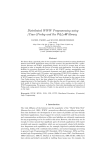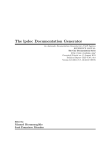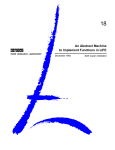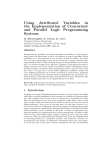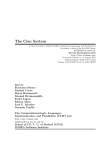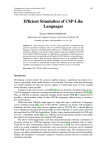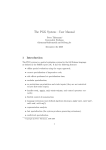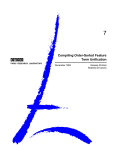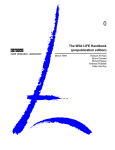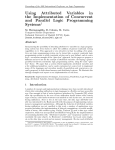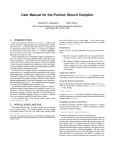Download Analyzing Logic Programs with Dynamic Scheduling
Transcript
Analyzing Logic Programs with Dynamic Scheduling
Kim Marriott
Dept. of Computer Science
Monash University, Clayton Vic 3168
Australia
marriottOcs.monash.edu.au
María José García de la Banda
Manuel Hermenegildo
Facultad de Informática - UPM
28660-Boadilla del Monte, Madrid
Spain
{maria,herme}@fi.upm.es
Abstract
Traditional logic programming languages, such as
Prolog, use a fixed left-to-right atom scheduling rule. Recent logic programming languages,
however, usually provide more flexible scheduling in which computation generally proceeds leftto-right but in which some calis are dynamically
"delayed" until their arguments are sufRciently instantiated to allow the cali to run efficiently. Such
dynamic scheduling has a significant cost. We give
a framework for the global analysis of logic programming languages with dynamic scheduling and
show that program analysis based on this framework supports optimizations which remove much
of the overhead of dynamic scheduling.
1
Introduction
The first logic programming languages, such as DEC10 Prolog, used a fixed scheduling rule in which all
atoms in the goal were processed left-to-right. Unfortunately, this meant that programs written in a clean,
declarative style were often very inefficient, only terminated when certain inputs were fully instantiated or
"ground", and (if negation was used) produced wrong
results. For this reason there has been widespread
interest in a class of "second-generation" logic programming languages, such as IC-Prolog, NU-Prolog,
Prolog-II, Sicstus-Prolog, Prolog-III, CHIP, Prolog M,
and SEPIA, etc., that provide more flexible scheduling
in which computation generally proceeds left-to-right
but in which some calis are dynamically "delayed" until their arguments are sufficiently instantiated to allow the cali to run efficiently. Such dynamic schedul-
ing overcomes the problems associated with traditional
Prologs and their fixed scheduling. First, it allows the
same program to have many different and efficient operational semantics as the operational behaviour depends
on which arguments are supplied in the query. Thus,
programs really behave efficiently as relations, rather
than as functions. Second, the treatment of negation
is sound, as negative calis are delayed until all arguments are ground. Third, it allows intelligent search
in combinatorial constraint problems. Finally, dynamic
scheduling allows a new style of programming in which
Prolog procedures are viewed as processes which communicate asynchronously through shared variables.
Unfortunately, dynamic scheduling has a significant cost; goals, if affected by a delay declaration, must
be checked to see whether they should delay or not;
upon variable binding, possibly delayed calis must be
woken or put in a "pending" list, so that they are woken
before the next goal is executed; also, few register allocation optimizations can be performed for delayed goals;
finally, space needs to be allocated for delayed goals
until they are woken [1]. Furthermore, global dataflow
analyses used in the compilation of traditional Prologs,
such as mode analysis, are not correct with dynamic
scheduling. This means that compilers for languages
with dynamic scheduling are currently unable to perform optimizations which improve execution speed of
traditional Prologs by an order of magnitude [19, 21,
31, 32, 33]. However, it is not simple to extend analyses for traditional Prologs to languages with dynamic
scheduling, as in existing analyses the fixed scheduling
is crucial to ensure correctness and termination.
Here we develop a framework for global dataflow
analysis of logic languages with dynamic scheduling.
This provides the basis for optimizations which remove
the overhead of dynamic scheduling and promises to
make the performance of logic languages with dynamic
scheduling competitive with traditional Prolog.
First, we give a denotational semantics for languages with dynamic scheduling. This provides the semantic basis for our generic analysis. The main differ-
ence with denotational deñnitions for traditional Prolog
is that sequences of delayed atoms must also be abstracted and are included in "calis" and "answers". A
key feature of the semantics is to approximate sequences
of delayed atoms by multisets of atoms which are annotated to indicate if they are possibly delayed or if they
are definitely delayed. The use of multisets instead of
sequences greatly simplifies the semantics with, we believe, little loss of precisión. This is because in most
"real" programs delayed atoms which wake at the same
time are independent while delayed atoms which are
dependent will be woken at different times.
Second, we give a generic global dataflow analysis
algorithm which is based on the denotational semantics.
Correctness is formalized in terms of abstract interpretation [7]. The analysis gives information about cali
arguments and the delayed calis, as well as implicit information about possible cali schedulings at runtime.
The analysis is generic in the sense that it has a parametric domain and various parametric functions. The
parametric domain is the descriptions chosen to approximate sets of term equations. Different choices of descriptions and associated parametric functions provide
different information and give different accuracy. The
parametric functions also allow the analysis to be tailored to particular system or language dependent criteria for delaying and waking calis. Implementation of the
analysis is by means of a "memoization table" in which
information about the "calis" and their "answers" encountered in the derivations from a particular goal are
iteratively computed.
Finally, we demónstrate the utility and practical
importance of the dataflow analysis algorithm. We
sketch an example instantiation of the generic analysis
which gives information about groundness and freeness
of variables in the delayed and actual calis. Information
from the example analysis can be used to optimize target code in many different ways. In particular, it can
be used to reduce the overhead of dynamic scheduling
by removing unnecessary tests for delaying and awakening and by reordering goals so that atoms are not
delayed. It can also be used to perform optimizations
used in the compilation of traditional Prolog such as:
recognizing determínate code and so allowing unnecessary backtrack points to be deleted; improving the code
generated for unification; recognizing calis which are
"independent" and so allow the program to be run in
parallel, etc. Preliminary test results, given here, show
that the analysis and associated optimizations used to
reduce the overhead of dynamic scheduling give significant improvements in the performance of these languages.
Abstract interpretation of standard Prolog was
suggested by Mellish [26] as a way to formalize mode
analysis. Since then, it has been an active research área
and many frameworks and applications have been given,
for example see [9]. The approach to program analysis taken here is based on the denotational approach
of Marriott et. al. [25]. A common implementation
of abstract interpretation based analyses of Prolog is in
terms of "memoization tables" [11, 13] which our analysis generalizes. To our knowledge this is the first paper
to consider the global dataflow analysis of logic programming languages with delay. Related work includes
Marriott et. al. [24] which gives a dataflow analysis for
a logic programming language in which negated calis are
delayed until their arguments are fully ground. However
the analysis does not generalize to the case considered
here as correctness relies on calis only being woken when
all of their arguments are ground. Other related work
is the global analysis of concurrent constraint programming languages [4, 5, 6, 14]. These languages differ from
the languages considered here as they do not have a default left-to-right scheduling but instead the compiler or
interpreter is free to choose any scheduling. Thus, program analysis must be correct for all schedulings. In
our setting, knowledge of the default scheduling allows
much more precise analysis. Related work also includes
Gudeman et. al. [16] and Debray [12] which investígate
local analyses and optimization for the compilation of
Janus, a concurrent constraint programming language.
The optimizations include reordering and removal of
redundant suspensión conditions. Debray [10] studies
global analysis for compile-time fixed scheduling rules
other than left-to-right. However this approach does
not work for dynamic scheduling, ñor for analyses to
determine "freeness" information. Finally, Hanus [17]
gives an analysis for improving the residuation mechanism in functional logic programming languages. This
analysis handles the delay and waking of equality constraints, but does not easily extend to handle atoms as
these may spawn subcomputations which in turn have
delayed atoms.
In the next section we give a simple example to illustrate the usefulness of dynamic scheduling and the
type of information our analysis can provide. In Section
3 we give the operational semantics of logic languages
with dynamic scheduling. In Section 4 we review abstract interpretation and introduce various descriptions
used in the analysis. In Section 5 we give the denotational semantics. In Section 6 we give the generic
analysis, and in Section 7 we give modifications which
ensure termination. In Section 8 we give an example
analysis. Section 9 presents some performance results
and in Section 10 we conclude.
2
Example
The following program adapted from Naish [30], illustrates the power of allowing calis to delay and the information our analysis can provide. The program permute
is a simple definition of the relationship that the first
argument is a permutation of the second argument.
It makes use of the procedure delete(X, Y, Z) which
holds if Z is the list obtained by removing X from the
list Y.
pernnrte(X, Y)
• * -
perimite(X, Y)
•í-
delete(X,Y,Z)
delete(X,Y,Z)
•í•í-
X = nil,
Y = nil.
X =U:X1,
delete(U,Y,Z),
p e r m u t e ( X l , Z).
Y = X : Z.
Y = U : Yl,
Z = U : Zl,
delete(X,Yl,Zl)
Note that uppercase letters denote variables.
Clearly the relation declaratively given by permute is
symmetric. Unfortunately, the behavior of the program
with traditional Prolog is not: Given the query, Q l ,
? — pernnrte(X, a : b : n i l )
Prolog will correctly backtrack through the answers
X = a : b : nil and X — b : a : nil. However for the
query, Q2,
? — perimrte(a : b : n i l , X)
Prolog will ñrst return the answer X = a : b : nil
and on subsequent backtracking will go into an infinite
derivation without returning any more answers.
For languages with delay the program permute
does behave symmetrically. For instance, if the above
program is given to the NU-Prolog compiler, a preprocessor will genérate the following when declarations:
? — permute(X, Y)whenXorY.
? - delete(X,Y : Z,U)whenZorU.
These may be read as saying that the cali
permute(X, Y) should delay until X or Y is not a
variable, and that the cali delete(X,Y : Z,U) should
delay until Z or U is not a variable. Of course programmers can also annotate their programs with when declarations. Given these declarations, both of the above
queries will behave in a symmetric fashion, backtracking through the possible permutations and then failing.
What happens is that with Q l execution proceeds
as in standard Prolog because no atoms are delayed.
With Q2, however, calis to delete are delayed and only
woken after the recursive calis to permute.
The dataflow analysis developed in this paper, can
be used to analyze this program with these queries. In
the case of Q l it will determine that the overhead of
delaying is not needed as no cali ever delays if the second
argument is ground. Furthermore, it will also determine
that in all calis to permute the first argument will be
a variable and the second argument will be ground, and
in all calis to delete the first and third arguments will
be variables, and the second will be ground. This can
be used to optimize the code for unification. In the case
of Q2 it will determine that all calis to delete from the
second clause delay. Furthermore, that in all calis to
permute the first argument will be ground and in all
calis to delete when unification is performed, the first
and third arguments will be ground, and the second will
be a variable. The reader is encouraged to check that
this is indeed true! Again this information can be used
to optimize the code for unification, parallelism or other
purposes. The benefits obtained from the optimizations
made possible with such information are illustrated by
the performance results presented in Section 9.
We note that if a traditional mode analysis is performed with the query Q2 it will ignore delaying and
incorrectly genérate the information that the third argument of delete is free (which it would be in the nonterminating execution that the analyzer would be approximating) rather than ground.
3
Operational Semantics
In this section we give some preliminary notation and an
operational semantics for logic programs with dynamic
scheduling.
A logic program, or program, is a finite set of
clauses. A clause is of the form H i- B where H, the
head, is an atom and B , the body, is a finite sequence of
literals. A literal is either an atom or an equation between terms. An atom has the form p(xi, ...,x n ) where
p is a predicate symbol and the x¡ are distinct variables.
An equality constraint is essentially a conjunction
of equations between terms. For technical convenience
equality constraints are treated modulo logical equivalence, and are assumed to be closed under existential quantification and conjunction. Thus equality constraints are ordered by logical implication, that is 0 < 6'
iff 8 =>• 9'. The least, inconsistent equality constraint
is denoted by false. We let 3 W # denote the equality
constraint 3 Vi 3 V2 • - • V„# where variable set W =
{ V i , . . . , V n } . We let 3 W # be constraint 9 restricted
to the variables W . That is 3 W # is 3 v a / ^ v w 9 where
function vars takes a syntactic object and returns the
set of (free) variables occurring in it. Note that although we concéntrate on equality constraints, the analysis generalizes to handle other constraints, such as
arithmetic or Boolean, in the more general context of
constraint logic programs [22].
Var is the set of variables, Atom the set of atoms,
E q n s the set of equality constraints, Lit the set of literals, and Prog the set of programs.
A renaming is a bijective mapping from Var to
Var. We let Ren be the set of renamings, and naturally
extend renamings to mappings between atoms, clauses,
and constraints. Syntactic objects s and s' are said to
be variants if there is a p G Ren such that p s = s'.
The definition of an atom A in program P with respect
to variables W , defhp A W , is the set of variants of
clauses in P such that each variant has A as a head and
has variables disjoint from W \ (vars A).
The operational semantics of a program is in terms
of its "derivations" which are sequences of reductions
between "states" where a state (G,#,D) consists of the
current literal sequence or "goal" G, the current equality constraints 9, and the current sequence of delayed
atoms D. Literals in the goals are processed left-toright. If the literal is an equality constraint, and it is
consistent with the current equality constraints, it is
added to these. Delayed atoms woken by the addition
are processed. If the literal is an atom, it is tested to see
if it is delayed. If so it is placed in the delayed atom sequence, otherwise it is replaced by the body of a clause
in its definition.
More formally,
State
=
Lit* x Eqns x Atom*.
A state (L : G, 9, D) can be reduced as follows:
1. If L G E q n s and 9 A L is satisfiable, it is
reduced to {D' :: G,9 A L , D \ D') where D' =
(woken D 9 A L).
The remaining conditions ensure that delay behaves
reasonably. It should not take variable ñames into account:
(2)
Let p G Ren. delay A 9 O delay (p A) (p 9).
It should only be concerned with the effect of 9 on the
variables in A:
(3)
delay A 9 & delay A 3 ( v a r s
A)9.
Finally, if an atom is not delayed, adding more constraints should never cause it to delay:
(4)
If 9 < 9' and delay A 9, then delay A 9'.
Although these conditions can be relaxed, they simplify the analysis presentation and are met in existing
systems and languages.
The declarative semantics of a program is in terms
of its "qualified answers". Consider a derivation from
state S and program P with last state (G,#,D) where
G = nil. It is successful if D = nil and it flounders
otherwise. We say the tupie (#,D) is a qualified answer to S. It is understood as representing the logical
implication
3(™S)(DA9)^S.
For this reason we regard qualified answers (9, D) and
(#',D') to S as equivalent if
3(varsS)(DA0)o3(varsS)(D'AÍ?')-
In particular qualified answers tp and ip' are regarded as
the same if there is a renaming p such that (p tp) = ip1
and (p S) = S. As there is a non-deterministic choice of
2. If L G Atom there are two cases. If (delay L 9)
the clause in an atom's definition, there may be a numholds, it is reduced to (G,#,L : D). Otherwise it
ber of qualified answers generated from the initial state.
is reduced to (B :: G,#,D) for some (L <— B) G
We denote the set of qualified answers for a state S and
(defhp L (vars S)).
program P by qansp S. In the case of no calis delayNote that :: denotes concatenation of sequences. A
ing, this semantics is the same as the usual operational
derivation of state S for program P is a sequence of
semantics of Prolog with left-to-right scheduling.
states So —> Si —> ... —> S n where So is S and there is
As an example, consider the initial state
a reduction from each S¡ to S¡ + i.
(permute(X, Y ) , X = a : nil,nil) and the program
The above definition makes use of two parametric
from Section 2. These have the (single) successful
functions which are dependent on the systems or landerivation shown in Figure 1.
guage being modeled. These are, delay A 9, which
holds iff a cali to atom A delays with the equations 9,
4 Abstract Interpretation
and woken D 9, which is the subsequence of atoms
In abstract interpretation [7] an analysis is formalized
in the sequence of delayed calis D that are woken by
as a non-standard interpretation of the data types and
equations 9. Note that the order of the calis returned
functions over those types. Correctness of the analyby woken is system dependent.
sis with respect to the standard interpretation is arWe will assume that these functions satisfy the folgued by providing an "approximation relation" which
lowing four conditions. The first ensures that there is
holds whenever an element in a non-standard domain
a congruence between the conditions for delaying a cali
describes an element in the corresponding standard doand waking it:
main. We define the approximation relation in terms
(1) A G (woken D Í J Ü A E D A ^ (delay A 9). of an "abstraction function" which maps an element in
{ p e r m u t e ( X , Y ) , 0i, nil)
w h e r e 0i is X = a : nil
a{(X = U : X I ) : delete(U, Y, Z) : p e r m u t e ( X l , Z), 0i, nil)
a-
w h e r e 02 is 0i A X = U : X I
( d e l e t e ( U , Y , Z) : p e r m u t e ( X l , Z ) , 0 2 , nil)
a( p e r m u t e ( X l , Z ) , 0 2 , d e l e t e ( U , Y, Z)>
aw h e r e 03 is 02 A X I — nil
{XI = nil : Z = nil, 0 2 , delete(U, Y, Z))
(Z = nil, 0 3l
w h e r e 04 is 03 A Z = nil
delete(U,Y,Z))
( d e l e t e ( U , Y , Z ) , 0 4 , nil)
a-
w h e r e 05 is 04 A Y = U : Z.
(Y = U : Z, 04, nil)
a-Figure
1: Example Derivation
(nil, 0 5 , nil)
the standard domain to its "best" or most precise description.
A description (T>,a,£) consists of a description
domain V which must be a complete lattice, a data
domain £, and an abstraction function a : £ —> V.
We say that d a-approximates e, written d oc„ e, iff
(a e) < d. The approximation relation is lifted to functions, Cartesian-products and sets as follows.
AnnAtom
AnnMSet
Atom x Ann
p AnnAtom
Let D* G A n n M S e t . Define def D* to be the multiset
of atoms in D* that are annotated with def and all D*
to be the multiset of all atoms in D*, that is the atoms
annotated with either pos or def. The atom sequence
description is
( A n n M S e t , a An nMSet, Atom*)
• Let (T>i,ai,£i) and {T>2,012,£2) be descriptions,
and F : Vi —• T>2 and F ' : £\ —> £2 be functions. where aAnnMSet is defined by
Then F oc F ' iff Vd e Vx. Ve G £^ d oc ai e =>•
«AnnMSet D - {(A, def) | A in D}
(F d) <x„2 (F' e).
and A n n M S e t is ordered by DJ ^ D 2 iff
• Let (T>i,ai,£i) and {T>2,012,£2) be descriptions,
all T>1 C all D 2 * A def D¿ C def DJ.
and (di,d2) : T>\ x 2?2 and {ei,e2) : £\ x £2- Then
(di,d 2 > oc (ei,e 2 ) iff di oc ai ei A d 2 oca2 e 2 .
It follows that the annotated multiset D* approximates
• Let {T>, a, £) be a description and P ' C D and £' C
£. Then V oc £' iff Ve e £'. 3 d e X»'. d oc„ e.
When clear from the context we say that d approximates e and write d oc e and let V denote both the
description and the description domain.
In the analysis we will need to describe sequences of
delayed atoms and sequences of woken atoms. Because
of the inherent imprecisión in analyzing programs with a
dynamic computation rule, we cannot always be deñnite
that a particular atom is in the sequence, but may only
know that it is possibly in the sequence. Further, it is
difficult to keep track of all possible sequence orderings.
Henee, we will describe atom sequences by a multiset of
annotated atoms in which each atom is annotated with
def if it deñnitely appears in the sequence and pos if
it possibly appears in the sequence. For example, the
multiset {{p(X),pos),(q(Y),def)} describes only the
sequences p(X) : q(Y) : nil, q(Y) : p(X) : nil and
q(Y) : nil. More formally,
Ann
{def, pos}
the sequence D iff all atoms in D are in all D* and
every atom in def D* is in D.
We will also be interested in describing equality
constraints. The analysis given in the next section is
generic in the choice of description. We require that the
description chosen, ( A E q n s , a A E q n s , E q n s ) say, satisfies
« A E q n s 0 = J-AEqns
^
0 = false
where J-AEqns is the least element in A E q n s .
One example of an equality constraint description
is the standard equality constraint description,
(Eqns T ,A6'.6',Eqns)
in which constraints describe themselves. More precisely, the description domain is E q n s T which is the
set of constraint equalities with a new top element T.
E q n s T is a complete lattice ordered by
0 < 0' o B = false oi9 = 0' or 0' = T.
The abstraction function is the identity function, as the
best description of a constraint is just itself.
5
Denotational Semantics
and the denotation of a program has type
In this section we give a generic denotational semantics
for programs with dynamic scheduling. Correctness of
the denotational semantics depends on the following results about the operational semantics. T h e first proposition means t h a t we can find the qualiñed answers of
a state in terms of its constituent atoms, the second
means t h a t we can consider states modulo variable renaming, the third t h a t we can restrict the equality constraint to the variables in the delayed atoms and the
goal.
P r o p o s i t i o n 5.1 Let P £ P r o g , A £ A t o m and
(A : G , 0 , D ) £ S t a t e . Then q a n s P {A : G , 0 , D ) is
|J{qansp<G,6>',D') | <0',D'> e q a n s P ( A , 6 > , D ) } .
•
P r o p o s i t i o n 5.2 Let P £ P r o g , p £ R e n , and S £
State.
Q £ q a n s p S ü (p Q) e q a n s p (pS).
P r o p o s i t i o n 5.3 Let P
State.
q a n s p (G,6>,D) = \J{(9'
where S is ( G , 3 ( v a r s
£
•
P r o g and ( G , 0 , D )
£
A 6>,D')|(6>',D') £ q a n s P S } .
G ) u ( v a r s o)0,
D).
•
Taken together these propositions mean t h a t we
can find the qualiñed answers t o a state as long as we
know the qualiñed answers t o the "canonical" calis encountered when processing the state where a canonical
cali is a cali t h a t represents all of its variants and in
which the constraint is restricted to the variables of the
cali a t o m and the delayed atoms. This is the basic idea
behind the denotational semantics as the denotation of
a program is simply a mapping from calis to answers.
T h e last proposition means t h a t the meaning of
a goal is independent of the order t h a t the atoms are
scheduled. Thus we can ignore the sequencing information associated with delayed atoms and t r e a t t h e m
as multisets. It is variant of Theorem 4 in Yelick and
Zachary [34].
P r o p o s i t i o n 5.4 Let P be a program and ( G , 6, D ) be
a state. If G ' is a rearrangement of G then,
q a n s p ( G , 0 , D ) = q a n s P (G',6>,D).
•
In the denotational semantics atoms, bodies,
clauses and programs are formalized as "environment"
transformers where an environment consists of the current equality constraint description and an annotated
multiset of delayed atoms. In a sense an environment is
the current "answer". Thus an environment has type
Env
-
AEqns x AnnMSet
Den
=
A t o m —> E n v —> p E n v
as it maps a cali to its set of answers.
T h e complete denotational definition is shown in
Figure 2. The semantics is generic as it is parametric in A E q n s the equality constraint descriptions and
various parametric functions. T h e semantic functions
associated with programs P , clause bodies B , and literals L, need little explanation. T h e only point to note is
t h a t the variable set W is passed around so as to ensure
t h a t there are no variable (re)naming conflicts.
T h e function A gives the meaning of an a t o m
for the current denotation.
Consider the cali
A [A] W d (TT,D*).
There are three cases to consider:
the first is when A is delayed for all equality constraints
approximated by TT, the second is when A is not delayed
for any equality constraints approximated by TT, and the
third is when A is delayed for some equality constraints
approximated by TT, but not all. A is defined in terms
of the parametric functions A w a k e and A d e l a y . T h e
cali A w a k e A w returns a description of those equality constraints which are described by TT and for which
A will not delay. Conversely, A d e l a y A TT, returns a
description of those equality constraints which are described by w and for which A will delay. More exactly,
A w a k e and A d e l a y should satisfy:
{ ( A w a k e A TT)} OC {9 \ w oc 9 A -. (delay A 9)}
{ ( A d e l a y A TT)} OC {9 \ n oc 9 A (delay A 9)}.
Note t h a t A w a k e A TT = _LAEqns implies
TT <x9 =>• (delay
A9),
and A d e l a y A TT = J-AEqns implies
TT oc 9 => -i (delay A 9).
T h e auxiliary function l o o k u p is used to find the
denotation of an a t o m which possibly does not delay.
T h e cali, l o o k u p A W d (TT,D*), returns the denotation according t o d of A with environment (71", D * ) .
However there are complications because d only handles
"canonical calis". Henee l o o k u p must (1) restrict TT to
the variables in the cali; (2) rename the variables introduced in the delayed atoms in the answers so t h a t they
do not interfere with the variables in W ; and (3), combine the equality constraint description with t h a t of the
original cali so as to undo the result of the restriction.
L o o k u p is defined in terms of the parametric functions
A c o m b and A r e s t r i c t . A c o m b combines two equality constraint descriptions and should approximate the
function a d d , defined by
a d d 9 9' = 9 A 6»'.
The denotational semantics has semantic functions:
P
Q
B
L
A
E
P r o g —• D e n
P r o g —• D e n —> D e n
Lit* —• (p Var) —• D e n - • E n v - • ( p E n v )
Lit - • ( p V a r ) -» D e n - • E n v —• ( p E n v )
A t o m —• (p Var) —• D e n —• E n v —• ( p E n v )
E q n s - • ( p V a r ) - • D e n —• E n v —• ( p E n v ) .
It has auxiliary functions:
lookup
wmset
watom
A t o m —• (p Var) —• D e n —• E n v - • ( p E n v )
A n n M S e t - • (p Var) - • D e n - • E n v - • ( p E n v )
A n n A t o m —• ( p V a r ) —> D e n —¥ E n v —• ( p E n v )
and parametric functions:
Awake
Adelay
Acomb
Arestrict
Aadd
Awoken
Adelayed
A t o m —• A E q n s —• A E q n s
A t o m —>• A E q n s —¥ A E q n s
A E q n s —> A E q n s —• A E q n s
p Vars —> A E q n s —• A E q n s
E q n s —• A E q n s —> A E q n s
A n n M S e t -» E q n s - • A E q n s
A n n M S e t -» E q n s - • A E q n s
AnnMSet
AnnMSet.
The semantic and auxiliary functions are defined by:
P[P] A e
Q[P1 d A e
= A [A] (vars e) (lfp (Q [P])) e
— let V — vars e in
I J { ( B [B] V U (vars A <- B) d e) | (A «- B) € d e f n P A V }
B [nil] W d e
B [L : B] W d e
L[L]
A [A] W d < 7 r , D * )
E[fi]Wd(ir,D*)
lookup A Wd<7r,D*)
wmset 0 W d e
w m s e t (A* U D ' ) W d e
w a t o m (A, def) W d {TT, D*>
w a t o m (A, pos) W d {TV, D*)
= M
=
=
=
|J{(B[B]Wde')|e'e(L[L]Wde)}
if L G A t o m t h e n (A [L]) else (E [L])
if (Awake A TT) - J- A E q ns t h e n {(TT, {A, def) U D*)}
else if (Adelay A, TV) — J-AEqns t h e n (lookup A W d (TV, D*))
else {{Adelay(A, TT), (A, pos) U D*)}U
(lookup A W d ((Awake A TT), D*>)
— let TV = A a d d 8 TV in
if TV' — J-AEqns t h e n 0
else (wmset (Awoken D* 6 TV) W d {TV , (Adelayed D* 9 TV)))
— let V — (vars A) U (vars D*) in
let E = d A {(Arestrict V TV), D*) in
{((Acomb TT TT'), D*') | (TT', D*') € ( r e n a m e E V W ) }
—
= M
== [ J { ( w m s e t D* W d e') | e' G ( w a t o m A* W d e)}
== l o o k u p A W d ( 7 r , D * )
— {(TT, D*)} U (lookup A W d {(Awake A TT),D*))
Figure 2: Denotational Semantics
Arestrict restricts an equality constraint description
to a set of variables and should approximate the function restrict defined by
restrict W 9 = 3W9.
The deflnition also makes use of the function cali
rename E V W which returns a variant of the environments E which is disjoint from the variables W
but which leaves the variables in V unchanged. More
exactly it returns p E where p is a renaming such that
for all v G V, p v = v and vars (p E) n (W \ V) = 0.
Equations are handled by the semantic function
E. The function cali, E [0] W d <7r,D*), first adds
the equality constraint 9 to w and tests for satisfiability. If this succeeds, it then wakes up the atoms in
D*, and processes these. The definition is parametric in the functions Aadd, Awoken and Adelayed.
The function Aadd adds an equality constraint to an
equality constraint description and must approximate
the function add defined previously. Awoken returns
the multiset of atoms that will be possibly and definitely
woken by adding an equality constraint to an equality
constraint description and Adelayed returns the multiset of atoms that will possibly and definitely remain
delayed. Awoken must approximate difFwoken and
Adelayed must approximate diffdelay where these are
defined by
difFwoken D 8 9' = woken (D \ (woken T> 9')) 9
diffdelay D ^ ' ^ D \ (woken D (9 A 6')).
Note that Adelayed may change the annotation of
a delayed atom from def to pos and that Awoken
returns a multiset of woken atoms which are also annotated.
The woken atoms are handled by the auxiliary
functions wmset and watom almost exactly as if they
were a clause body, the only difference is to handle the
pos annotated atoms.
The standard denotational semantics, P s td, is obtained by from the denotational semantics by instantiating AEqns to the standard equality constraint descriptions and instantiating the parametric functions to the
function they are required to approximate, for instance
Aadd and Acomb are both instantiated to add. Using
the four propositions given at the start of this section,
it is possible to show that the denotational semantics is
correct:
Theorem 5.5 Let D G Atom*, 9 G Eqns, A G
Atom, and P G Prog. Then
P s t d [P] A (8,1)*) - qansp (A : nil,0,D>
where D* = a A n n MSet D.
•
Using results from abstract interpretation theory it
follows that analyses based on the semantics are correct:
Theorem 5.6 Let e G Env, A G Atom, P G Prog.
rfeoc(6>,D),
(P [P] A e) oc qansp {A : nil, 8, D).
•
Actually the denotational semantics does not exactly give the information a compiler requires for the
generation of efficient code. This is because we are primarily interested in removing unnecessary tests for delaying and improving the code for unification. Therefore, we must obtain information about the cali patterns. That is, for each atom A appearing in the program we want to know whether the calis to the atom
initially delay, and when each cali to A is eventually
reduced, perhaps after being delayed, the valué of the
current equation restricted to the variables in A. It is
straightforward to modify the denotational semantics
to collect this information for atoms which are not delayed. For the case of atoms which are delayed it is
more difficult as although treating the delayed atoms
as a multiset does not affect the qualiñed answers, if
more than one atom is woken it may affect the calis
made in the evaluation. Because of space limitations
we will ignore this extra complication but note that it
has been done in the analyzer used to obtain the results
presented in Section 9.
6
Implementation
The denotational equations given in the previous section can be considered as a definition of a class of program analyses. Read naively, the equations specify a
highly redundant way of computing certain mathematical objects. On the other hand, the denotational definitions can be given a "call-by-need" reading which
guarantees that the same partial result is not repeatedly recomputed and only computed if it is needed for
the final result. With such a call-by-need reading the
definition of P is, modulo syntactic rewriting, a working
implementation of a generic dataflow analyzer written
in a functional programming language.
In programming languages which do not support
a call-by-need semantics, implementation is somewhat
harder. To avoid redundant computations, the result of
invoking atom A in the context of environment e should
be recorded. Such memoing can be implemented using
function graphs. The function graph for a function f
is the set of pairs {(e i-> f(e)) | e G dom f} where
dom f denotes the domain for f. Computation of a
function graph is done in a demand-driven fashion so
that we only compute as much of it as is necessary in
order to answer a given query. This corresponds to the
"minimal function graph" semantics used by Jones and
Mycroft [23]. However, matters are complicated by the
fact that we are performing a fixpoint computation and
we must iteratively compute the result by means of the
function's Kleene sequence.
This idea leads to a generic algorithm for the
memoization based analysis of programs with dynamic
scheduling. The algorithm extends memoization based
analysis for traditional Prolog. The analysis starts from
a "cali" and incrementally builds a memoization table. This contains tupies of "calis" and their "answers"
which are encountered in derivations from the initial
cali. Calis are tupies of the form {A, TT, D*) where A is
an atom, D* is a multiset of annotated atoms describing the sequence of delayed atoms and TT is an equality
constraint description restricted to the variables in A
and D*. An answer to a cali (A,7r,D*) is of the form
(71"', D*') where D*' is a multiset of annotated atoms
describing the sequence of delayed atoms and TT' is an
equality constraint description restricted to the variables in A and D*'. Our actual implementation has
two improvements which reduce the size of the memoization table.
The first improvement, is when adding an answer to the answers of cali, to remove "redundant"
answers and merge similar answers together. Answers
(ni, T>1) and {TT-2, Dí;) are merged into the single answer
(TTI U T T 2 , D Í ) whenever Di; ^ D?.
The second improvement is to only consider calis
modulo variable renaming. Entries in the memoization
table are "canonical" and really represent equivalence
classes of calis and answers.
Another possible improvement which has not been
implemented yet is based on the observation that delayed atoms which are "independent" of the calling
atom can never be woken when the cali is executed.
Such atoms need not be considered in the cali as they
will occur in each answer. The exact definition of independence is somewhat difficult as it really means independence from any delayed atom which could be woken
in the cali.
7
Termination
Correctness of the denotational semantics, Theorem 5.6,
is not quite enough as it only guarantees partial correctness of an analysis, and, of course, we would also like
the analysis to terminate. Given that all calis to the
parametric functions terminate, the analysis will terminate iff there are a finite number of calis in the memoization table and each cali has a finite number of answers. This is true if the following two requirements are
met. The first is that for each finite set of variables W
there are only a finite number of descriptions which describe some equality constraints 3 W #. This is the usual
requirement for the termination of memoization based
analysis of standard Prolog. The second requirement is
that there is a bound on the size of the annotated multisets in both the calis and the answers. In this section we
sketch two modifications to the analysis which ensure
that only multisets of a bounded size need be considered, albeit at some loss of accuracy. In some sense,
this is a form of widening [8], however correctness does
not depend on the semantics of the description domain
but rather on properties of the program semantics.
The first modification allows us to only consider
calis with annotated multisets of a bounded size. Correctness depends on the following property of the operational semantics:
P r o p o s i t i o n 7.1 Let P
State. If D = D ' U D " ,
G P r o g and <G,#,D) G
qansp <G,6>,D) = q a n s P (G :: D ' , 0 , D " ) .
•
This means in the analysis that lookup can be modified
to (1) remove annotated atoms D* from the multiset of
delayed atoms, if it is to large, (2) proceed as before,
and then (3) process D* using a variant of B which
handles annotated atoms.
The second modification allows us to only consider
answers with annotated multisets of a bounded size.
Now a delayed atom A can, if it is woken, only add
constraints affecting variables in A and variables which
are local to its subcomputation. Thus in the analysis,
when we encounter an answer (TT, D*) in which the multiset D* is too large, we can replace it by the answer
(TT1 , {{T,pos)}) where {TT1} approximates
{# A 3 ( v a r s D í ) 0 ' | TT ex 9 A 6' G Eqns}
and (T,pos) is a special annotated "atom" which signifies that there are possibly delayed atoms of indeterminate ñame. Note that (T,pos) can never be woken.
With these two modifications the analysis will terminate whenever the usual termination requirements for
memoization based analysis of standard Prolog are met.
We can also use the idea behind the second modification to analyse modules. The problem is that when
analyzing a module in isolation from the context in
which it will be used we have no idea of the delayed
atoms associated with calis to the module. However,
the delayed atoms can only affect variables in the initial cali. Thus by taking the downward closure of the
initial cali, we are assured to obtain correct information about the calling patterns regardless of the atoms
delayed in the actual cali.
Another approach to ensure termination would be
to approximate the delayed multiset of atoms by a "star
abstraction" [4] in which variants of the same atom are
collapsed on to a single "canonical" atom.
8
Example Analysis
We now present an example of the analysis algorithm's
use. In our example analysis we use "simple modes"
to describe the equality constraints. We will use this
Table after lst Iteration:
<permute(X,Y),<{Y},{X},0),0>
^
0
Table after 2nd Iteration:
<permute(X,Y),<{Y},{X},0),0>
^
{(({X, Y } , 0 , 0>, 0 »
{delete(U,Y,Z),({Y},{U,Z},0>,0}
^
0
^
^
{(({X, Y } , 0 , 0>, 0 »
{(({U, Y, Z}, 0, 0>, 0}}
Table after 3rd and Final Iteration:
<permute(X,Y),<{Y},{X},0),0>
<delete(U,Y,Z),<{Y},{U,Z},0>,0>
Analysisof < p e r m u t e ( X , Y ) , ( { Y } , { X } , 0 ) , n i l ) .
Table after lst Iteration:
<permute(X,Y),<{X},{Y},0),0>
^
0
Table after 2nd Iteration:
<permute(X,Y),<{X},{Y},0),0>
{delete(U,Y,Z),({U,Z},{Y},0>,0}
^
^
{(({X, Y } , 0 , 0>, 0 »
0
^
^
{(({X, Y } , 0 , 0>, 0 »
{(({U, Y, Z}, 0, 0>, 0}}
Table after 3rd and Final Iteration:
<permute(X,Y),<{X},{Y},0),0>
<delete(U,Y,Z),({U,Z},{Y},0>,0>
Analysisof <permute(X, Y), ({X}, {Y}, 0),nil).
Figure 3: Example Analyses
mode descriptions to analyze the state corresponding to
query Q l from Section 2. The domain used is similar to
that of [28] and has been used for analyzing traditional
Prolog. A mode description for equality constraint 9
has the form
\ * gnd , V free , VV dep /
where V g n d is the set of variables that 0 definitely
grounds, Vf ree is the set of variables that 9 leaves definitely "free", that is not instantiated to a non-variable
term, and W d e p the set of sets of variables which 9
makes possibly dependent. For example, the equality
constraint
X = a A Y = Z A W = f (V)
is (most precisely) described by
<{X},{Y,Z},{{Y,Z},{W,V}}>.
A more complete description of this description domain
and abstract operations over it can be found in [28].
Of course for accuracy more complex domains could be
used in the analysis.
The first state description to be analyzed is
(permute(X, Y), ({Y}, {X}, 0), nil).
Figure 3 shows the memoization table at each iteration
in the analysis for this state description. The result
of the analysis is {(({X, Y},0,0),0)}. That is, if calis
to p e r m u t e have their second argument ground and
first argument free, the answers will ground the first
argument. As no calis were delayed in this example,
the analysis was virtually the same as given by a traditional left-to-right mode analysis of the program. If the
analysis is extended to give information about cali patterns it shows, as promised in Section 2, that for calis to
p e r m u t e in which the second argument is ground, and
the first free, no atom ever delays. Further, it shows
that in all calis to p e r m u t e the first argument will be
free and the second argument will be ground, and in
all calis to delete the first and third arguments will be
free, and the second will be ground.
Now consider the state description
{permute(X,Y),({X},{Y},0),nil).
Figure 3 shows the memoization table at each iteration
in the analysis for this state description. The result
of the analysis is {(({X, Y},0,0),0)}. That is, if calis
to p e r m u t e have their first argument ground and second argument free, the answers will ground the second
argument. Termination is achieved by restricting calis
in the memoization table so that they have an empty
annotated multiset. Thus when the cali
( p e r m u t e ( X l , Z), {{XI, U } , {Y, Z}, 0),
{(delete(U,Y,Z),def)})
is encountered when processing the second clause of
permute, first the cali
(permute(Xl, Z), ({XI}, {Z}, 0), 0),
is looked up in the table and then, as this grounds Z,
the cali
(delete(U, Y, Z), <{U, Z}, {Y}, 0), 0),
is looked up. If the analysis is extended to give information about cali patterns it gives the results promised
in Section 2.
9
Performance Results
We conclude with an empirical evaluation of the accuracy and usefulness of an implementation in Prolog of
the analyzer presented. Our ñrst results show that information from the analysis can be used to eliminate
redundant delay declarations, leading to a large performance improvement. The last test illustrates how the
analysis can be used to guide optimizations which are
performed for traditional Prolog. In this case we show
how implicit independent and-parallelism as detected
by the analyzer can be used to parallelize the benchmark.
The benchmarks used for the evaluation were:
permute, the permute program presented in Section 2;
q s o r t , the classical quick sort program using append;
app3 which concatenates three lists by performing two
consecutive calis to append; nrev which naively reverses
a list; and neg, an implementation of safe negation using suspensión on the groundness of the negated goal
(a simple test of membership in a list). All benchmarks
have been implemented in a reversible way, so that they
can be used forwards and backwards, through the use
of suspensión declarations.
In the first test, the optimizations to eliminate unnecessary delaying were performed in two steps. The
first step was to eliminate and/or relax suspensión declarations as indicated by the analysis. The second step
was to reorder the clause bodies provided the analysis
indicated that it reduced suspensión. It is important to
note that although the obtained orderings are already
implicit in the results of the (first) analysis, in order
to eliminate suspensión conditions that are redundant
after the reordering, a second pass of the analysis is
sometimes needed. The tests where performed with Sicstus Prolog 2.1, which is an efficient implementation of
Prolog with a rich set of suspensión primitives.
Due to lack of space we cannot include the code
for the benchmarks and their resulting specialized versions. However, in order to give an idea of the accuracy
of the analyzer and to help in understanding the efficiency results, we point out that in all cases but for
permute the information provided by the analyzer was
optimal. In the case of permute one condition can be
relaxed beyond those inferred by the analyzer. In particular, for all the examples in their "forward" execution mode the analyzer accurately infers that no goal
suspends and therefore all suspensión declarations can
be eliminated. With respect to the backwards execution, in all cases but neg the suspensión conditions are
either relaxed or eliminated. This does not occur for
neg since the analyzer accurately infers that the existing groundness suspensión condition is still needed for
correctness. Finally, with respect to the optimizations
where reordering is allowed, all backward executions are
reordered in such a way that no suspensión conditions
are needed. Thus, we can conclude that the accuracy
results for the analyzer are encouraging.
Table 1 lists execution times, expressed in seconds,
for the original benchmarks and the optimized versions.
Each column has the following meaning: Ñame - program ñame, Query - number of elements in the list
given as query, P - execution time for the program
written in standard Prolog, i.e. with no suspensión declarations, S - execution time for the program written
with suspensión declarations, SO - execution time for
program written with suspensión declarations and optimized by removing suspensión declarations as dictated
by the analysis information, S/SO - ratio between the
last two columns, R - execution time for the program
optimized by reordering the clause bodies as dictated
by the analysis information, and R / S - ratio between
R and S columns. In the P column I n stands for nontermination, and E r stands for a wrong result or an
execution error (the fact that these cases appear shows
the superiority of the versión of the program with suspensión declarations). Two sets of data (corresponding
to two lines in the table) are given for each program,
the first one corresponding to "forwards" execution of
the program, the second to the "backwards" execution.
Note that in some cases the number of elements
given as queries for forward execution are different from
those used for the backward execution of the same program. The reason is the amount of time required by
each query due to the different behaviour when running forwards (one solution) and backwards (múltiple
solutions).
The results are rather appealing as they show that
the optimizations based on relaxing and eliminating suspensión declarations using the information provided by
the analyzer allows use of the more general versión of
the program written with suspensión declarations with-
Ñame
permute
app3
qsort
nrev
neg
Query
8
8
20000
1000
2000
7
300
300
400000
400000
P
In
2.0
0.2
In
0.8
Er
0.2
In
2.4
Er
S
27.2
20.6
4.7
12.2
74.3
20.8
21.4
28.4
3.5
3.5
SO
24.0
2.0
0.2
1.6
0.8
4.7
0.2
3.1
2.4
3.5
s/so
1.1
10.3
23.5
7.6
92.9
4.4
107.0
9.2
1.5
1.0
R
0.7
2.0
0.2
1.4
0.8
0.7
0.2
0.5
2.4
2.4
S/R
38.9
10.3
1.5
8.7
92.9
29.7
107.0
56.8
1.5
1.5
Table 1: Analysis and optimization with delay
"Reversible" quick-sort, 5000 elements
Standard Prolog
Suspensión declarations, after analysis and reordering
Above program, parallelized, 1 processor
Above program, parallelized, 2 processors
Above program, parallelized, 4 processors
Above program, parallelized, 6 processors
Time
1.23
1.23
1.30
0.81
0.53
0.46
Table 2: Analysis and optimization of quick-sort
out a performance penalty when executing the program
in the mode that runs in Prolog. Furthermore, the analysis and resultant optimization also improves execution
speed even if some suspensions still need to be used
during execution. The optimizations based on reordering give even more impressive results. This is mainly
explained by the fact mentioned above that for all programs the reordering has achieved the elimination of all
suspensión declarations.
Finally, in the last test, we show how information
from the analysis can be used to perform optimizations
used in the compilation of traditional Prolog. As an example we consider automatic parallelization based on
the independent and parallelism model. The only program in which this kind of parallelism exists for the
given queries is q s o r t . In this case the parallelism can
be automatically exploited using existing tools given
the information obtained from the analysis. This is because the analysis determines that there is no goal suspensión in the reordered program and so the tools and
techniques described in [20, 27] are applicable. These
techniques can also be extended to deal with cases in
which goals are delayed by extending the notion of dependence, but that is beyond the scope of this paper.
A significant reduction in computation time is obtained
from parallelism at least for the forward query. This is
illustrated in Table 2, which shows results from running
the forward query with the optimized program under &Prolog [19], a parallel versión of Sicstus Prolog, running
on a commercial multiprocessor. Times are in seconds.
10
Conclusión
We have given a framework for global dataflow analysis of logic languages with dynamic scheduling. The
framework extends memoization based analyses for traditional logic programming languages with a fixed leftto-right scheduling. Information from analyses based
on the framework can be used to perform optimizations
which remove the overhead of dynamic scheduling and
also to perform optimizations used in the compilation
of traditional Prolog.
A potential application of the framework is for
the analysis of constraint logic programming languages
which handle difncult constraints by delaying them until they become simpler. Information from an analysis
based on our framework could be used to avoid testing
constraints for difficulty at run-time, or to move difncult
constraints to points in the program in which they are
simpler, thus avoiding suspensions. An analysis specifically for this purpose has also recently been suggested
by Hanus [18].
References
[1] M. Carlsson. Freeze, Indexing, and Other Implementation Issues in the Wam. In Fourih International Con-
[2]
[3]
[4]
[5]
ference on Logic Programming, pages 40-58. University
of Melbourne, MIT Press, May 1987.
M. Carlsson. Sicstus Prolog User's Manual. Po Box
1263, S-16313 Spanga, Sweden, February 1988.
M. Codish. A Provably Correct Algorithm for Sharing
and Freeness Inference. In 1992 Workshop on Staüc
Analysis WSA '92, September 1992.
M. Codish, M. Falaschi, and K. Marriott. Suspensión
Analysis for Concurrent Logic Programs. In K. Furukawa, editor, Proc. Eighth Int'l Conf. on Logic Programming, pages 331- 345. The MIT Press, Cambridge,
Mass., 1991.
M. Codish, M. Falaschi, K. Marriott and W. Winsborough. Efficient analysis of concurrent constraint logic
programs. Proc. of Twentieth Int. Coll. Autómata,
Languages and Programming, A. Lingus and R. Karlsson and S. Carlsson (Ed.), LNCS Springer Verlag,
pages 633-644.
[6] C. Codognet, P. Codognet, and M. Corsini. Abstract
Interpretation for Concurrent Logic Languages. In
S. Debray and M. Hermenegildo, editors, Proc. North
American Conf. on Logic Programming'90, pages 215232. The MIT Press, Cambridge, Mass., 1990.
[7] P. Cousot and R. Cousot. Abstract Interpretation: a
Unified Lattice Model for Static Analysis of Programs
by Construction or Approximation of Fixpoints. Proc.
of the Fourth ACM Symposium on Principies of Programming Languages, 238-252, 1977.
[8] P. Cousot and R. Cousot. Comparing the Galois Connection and Widening/Narrowing Approaches to Abstract Interpretation. Technical report, LIX, Ecole
Polytechnique, France, 1991.
[9] P. Cousot and R. Cousot. Abstract Interpretation and
Application to Logic Programs. Journal of Logic Programming, 13(2 and 3):103-179, July 1992.
[10] S. Debray. Static Analysis of Parallel Logic Programs.
In Fifth Int'l Conference and Symposium on Logic
Programming, Seattle,Wasinghton, August 1988. MIT
Press.
[11] S. K. Debray. Static Inference of Modes and Data Dependencies in Logic Programs. ACM Transactions on
Programming Languages and Systems 11 (3), 418-450,
1989.
[12] S.K. Debray. QD-Janus: A Sequential Implementation
of Janus in Prolog. Technical Report, University of Arizona, 1993.
[13] S. K. Debray and D. S. Warren. Functional Computations in Logic Programs. ACM Transactions on Programming Languages and Systems 11 (3), 451-481,
1989.
[16] D. Gudeman, K. De Bosschere and S.K. Debray. j e :
An Efficient and Portable Sequential Implementation
of Janus. In Proc. of 1992 Joint International Conference and Symposium on Logic Programming, 399-413.
MIT Press, November 1992.
[17] M. Hanus. On the Completeness of Residuation. In
Proc. of 1992 Joint International Conference and Symposium on Logic Programming, 192-206. MIT Press,
November 1992.
[18] M. Hanus.
Analysis of Nonlinear Constraints in
CLP(R). In Proc. of 1993 International Conference
on Logic Programming, 83-99. MIT Press, June 1993.
[19] M. Hermenegildo and K. Greene. &-Prolog and its Performance: Exploiting Independent And-Parallelism. In
1990 International Conference on Logic Programming,
pages 253-268. MIT Press, June 1990.
[20] M. Hermenegildo, R. Warren, and S. Debray. Global
Flow Analysis as a Practical Compilation Tool. Journal of Logic Programming, 3(4):349-367, August 1992.
[21] T. Hickey and S. Mudambi. Global Compilation of Prolog. Journal of Logic Programming, 7, 193-230, 1989.
[22] J. Jaffar and J.-L. Lassez. Constraint Logic Programming. In Proc. Fourteenth Ann. ACM Symp. Principies
of Programming Languages, pages 111-119, 1987.
[23] N. D. Jones and A. Mycroft. Dataflow analysis of applicative programs using minimal function graphs. In
Proc. Thirteenth Ann. ACM Symp. Principies of Programming Languages, pages 296-306. St. Petersburg,
Florida, 1986.
[24] K. Marriott, H. S0ndergaard, and P. Dart. A characterization of non-floundering logic programs. In S. K.
Debray and M. Hermenegildo, editors, Logic Programming: Proc. North American Conf. 1990, pages 661680. MIT Press, 1990.
[25] K. Marriott, H. S0ndergaard and N. D. Jones. Denotational abstract interpretation of logic programs. To
appear in ACM Trans. Programming Languages and
Systems.
[26] C. S. Mellish. The automatic generation of mode
declarations for Prolog programs. Technical Report
163, Dept. of Artificial Intelligence, University of Edinburgh, Scotland, 1981.
[27] K. Muthukumar and M. Hermenegildo. The CDG,
UDG, and MEL Methods for Automatic Compiletime Parallelization of Logic Programs for Independent
And-parallelism. In 1990 International Conference on
Logic Programming, pages 221-237. MIT Press, June
1990.
[14] M. Falaschi, M. Gabbrielli, K. Marriott and C.
Palamidessi. Compositional analysis for concurrent
constraint programming. IEEE Symposium on Logic in
Computer Science, Montreal, June 1993.
[28] K. Muthukumar and M. Hermenegildo. Combined Determination of Sharing and Freeness of Program Variables Through Abstract Interpretation. In 1991 International Conference on Logic Programming, pages
49-63. MIT Press, June 1991.
[15] M. Garcia de la Banda and M. Hermenegildo. A Practical Application of Sharing and Freeness Inference. In
1992 Workshop on Static Analysis WSA '92, pages 118125, Bourdeaux, France, September 1992.
[29] K. Muthukumar and M. Hermenegildo. Compile-time
Derivation of Variable Dependency Using Abstract Interpretation. Journal of Logic Programming, 13(2 and
3):315-347, July 1992.
[30] L. Naish. Negation and Control in Prolog, LNCS 238,
Springer-Verlag, 1985.
[31] A. Taylor. LIPS on a MIPS: Results from a Prolog
Compiler for a RISC. Proc. of the Ith International
Conference on Logic Programming, 174-185, 1990.
[32] P. Van Roy and A.M. Despain. The Benefits of Global
Dataflow Analysis for an Optimizing Prolog Compiler.
Proc. of the 1990 North American Conference on Logic
Programming, 501-515, 1990.
[33] R. Warren, M. Hermenegildo and S.K. Debray. On
the Practicality of Global Flow Analysis of Logic Programs. Proc. of the 5th International Conference and
Symposium on Logic Programming, 684-699, 1988.
[34] K. Yelick and J. Zachary. Moded type systems for logic
programming. In Proc. Sixteenth Annual ACM Symp.
on Principies of Programming Languages, pages 116—
124. ACM, 1989.
















